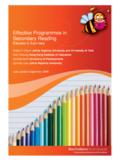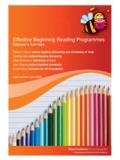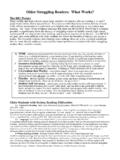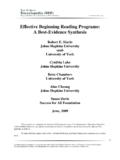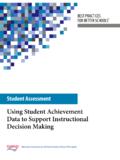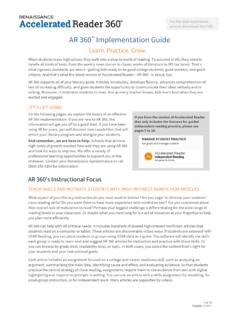Transcription of Effective programmes for struggling readers - Best …
1 Effective programmes for struggling readers A best - evidence Synthesis Robert E Slavin Johns Hopkins University and the University of York Cynthia Lake Johns Hopkins University Susan Davies Success for All Foundation Nancy A Madden Johns Hopkins University and the University of York Last updated July 2009 The importance of getting children off to a good start in reading cannot be overstated. Success in primary school is virtually synonymous with success in reading, and those children who lack these skills as they move to secondary education will face problems in every subject as a result. But which primary reading approaches have been proven to help struggling readers to succeed? This review summarises research on six types of programmes for struggling readers . We looked at all available evidence on programmes designed to improve the reading achievement of primary school children having difficulty in learning to read, in order to establish what we know works.
2 We examined all studies of relevant reading programmes from all countries, as long as a report was available in English.* (NB Most studies took place in the US). We were then able to assess and compare the effectiveness of these programmes . Descriptions and ratings for all the programmes are listed further down this summary. The results of the review show that although small-group tutoring can be Effective , one-to-one tutoring provides most Effective results. Furthermore, an emphasis on phonics greatly improves outcomes. IT programmes have little impact on reading. The full report (which this review summarises) is available at One-to-One Tutoring by Teachers (TT) (Such as Reading Recovery) The review showed that one-to-one tutoring by teachers works, and that teachers are more Effective as tutors than paraprofessionals or volunteers.
3 Effect size = + in 19 studies Reading Recovery: Effect size = + in 8 studies Other programs: Effect size = + in 11 studies One-to-One Tutoring by Paraprofessionals and volunteers (T-PV) (Such as Sound Partners, SMART, and Book Buddies) However, the review also showed that the effects seen for paraprofessional and volunteer tutors using structured and intensive programmes were positive, and pose a real challenge to the idea that only qualified teachers can be Effective tutors. Effect size = + in 18 studies Paraprofessionals: Effect size = + in 11 studies Volunteers: Effect size = + in 7 studies Small Group Tutorials (SGT) (Such as Corrective Reading, Quick Reads, Voyager Passport, and Empower Reading) Small Group Tutorials are the most common form of supplementary instruction for struggling readers . However, the studies of SGT that were included in this review (because they met the inclusion criteria) were not run-of-the-mill , but named programmes with extensive training, materials, and a strong emphasis on phonics.
4 Effect size = + in 11 studies. Classroom Teaching Process Approaches (CTP) The results for classroom teaching process programmes were very positive for pupils who had the lowest performance levels in their classes. The effect size was similar to the findings for one-to-one phonetic tutoring. Effect size = + in 16 studies Cooperative Learning: Effect size =+ in 8 studies Classroom Teaching Process programmes with Tutoring (CTP + TT) The effect size for the lowest achievers in Success for All was similar to the effect size for phonetic tutoring programmes . NB. Success for All was the only programme in this section. Effect size = + in 9 studies. Teaching Technology (IT) IT had minimal impacts on the achievement of struggling readers . Effect size = + in 14 studies. *Overall, 96 experimental-control comparisons met the inclusion criteria, of which 39 used random assignment to treatments, and five used randomised quasi-experiments.
5 Effect sizes (experimental-control differences as a proportion of a standard deviation) were averaged across studies, weighting by study sample size. programme Ratings Listed below are currently available programmes , grouped by strength of effectiveness. Within each group programmes available in the UK are listed first (and shaded), followed by the remainder in alphabetical order. The Type for each programme corresponds to the categories above (eg IP = Instructional Process Strategies). Key to programme Ratings Strong evidence of Effectiveness: At least two studies, one of which is a randomized or randomized quasi-experimental study, or multiple smaller studies, with a sample size-weighted effect size of at least + , and a collective sample size across all studies of at least 250 students.
6 To qualify for this category, effect sizes from the randomized studies must have a weighted mean effect size of at least + Moderate evidence of Effectiveness: At least two matched prospective studies, with a collective sample size of 250 pupils, and a weighted mean effect size of at least + Limited evidence of Effectiveness: Strong evidence of Modest Effects: Studies meet the criteria for moderate evidence of effectiveness except that the weighted mean effect size is + to + Limited evidence of Effectiveness: Weak evidence with Notable Effects: A weighted mean effect size of at least + based on one or more qualifying studies of any 12 qualifying design insufficient in number or sample size to meet the criteria for Moderate evidence of Effectiveness. Insufficient evidence of Effectiveness: Qualifying studies do not meet the criteria for limited evidence of effectiveness.
7 N No Qualifying Studies: No studies meet inclusion standards. Strong evidence of Effectiveness Rating programme Type Description Contact / Website Success for All CTP + TT Provides extensive training and materials focused on co-operative learning, phonics, and a rapid pace of instruction. Also provides tutoring to struggling children, mostly age 6/7. (Product training provided) Reading Recovery TT Provides the lowest achieving readers (lowest 20%) in year 2 With supplemental tutoring in addition to their normal reading classes. Website: Contact: Quick Reads SG A supplementary programme designed to increase fluency, build vocabulary and background knowledge, and improve comprehension. Website: Available to purchase from: Reading Intervention TT programme for children with the most significant literacy difficulties and who are in the beginning stages of learning to read and Contact: Information about the programme in Cumbria: / Rating programme Type Description Contact / Website write.
8 Children who take part in the programme will usually have had previous support in school. The programme is individually tailored, and delivered by intensively trained teachers and teaching assistants. Currently available only in Cumbria and Rochdale. North Yorkshire has also developed a small group version of the intervention. (Nb. This programme was known as Reading with Phonology during development). Direct Instruction/ Corrective Reading CTP, SGT A highly structured, phonetic approach to reading instruction that emphasizes phonics, a step-by-step teaching approach, and direct teaching of comprehension skills, as well as extensive professional development and follow-up. US website: Contact: Peer Assisted Learning Strategies CTP A technique in which children work in pairs, US website: Contact: Rating programme Type Description Contact / Website (PALS) taking turns as teacher and learner, to learn a structured sequence of literacy skills, such as phonemic awareness, phonics, sound blending, passage reading, and story re-telling.
9 Targeted Reading Intervention TT A one-to-one tutoring model in which classroom teachers work individually with struggling readers in Years 1 and 2 for 15 minutes a day. The 1-1 sessions focus on re-reading for fluency (2 min.), word work (6 min.), and guided oral reading (7 min.). Contact: One-to-One Teacher Tutoring with Phonics Emphasis TT programmes : 1) Auditory Discrimination in Depth (TT) 2) Early Steps/Howard Street Tutoring (TT) 3) Intensive Reading 4) Reading Rescue (TT) 1) US website: 2) Contact: 3) Contact: 4) US website: One-to-One Paraprofession al/Volunteer Tutoring with Phonics Emphasis T-P/V programmes : 1) Sound Partners (TPara) 2) The Reading Connection (T-Para) 3) SMART (T-1) Contact: 2) US website: 3) US website: 4) US website: Rating programme Type Description Contact / Website Para) 4) Reading Rescue (TPara) 5) Howard Street Tutoring (T-Para) 6) Book Buddies (TVolunteer) 5) Contact: 6) Contact.
10 (adaptable for use in any country) Moderate evidence of Effectiveness Rating programme Type Description Contact / Website Cooperative Integrated Reading and Composition (CIRC) CIRC is now disseminated as Literacy Wings CTP A co-operative learning programme designed to help pupils develop metacognitive strategies for comprehending narrative and expository text. (Product training provided) Limited evidence of Effectiveness: Strong evidence of Modest Effects Rating programme Type Description Contact / Website Jostens/ Compass Learning IT Provides an extensive set of assessments which place pupils according to their current levels of performance. Exercises are then designed primarily to fill gaps in their skills. US website: Limited evidence of Effectiveness: Weak evidence with Notable Effects Rating programme Type Description Contact / Website Early Intervention in Reading SGT Focuses on phonemic segmentation and blending, phonics instruction, story reading and re-reading, comprehension, Website: Contact: (Training is web-based, with monthly telephone contact for UK teachers) Rating programme Type Description Contact / Website and home reading.

